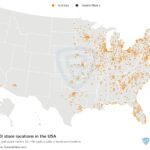Power outages can happen unexpectedly, and when they do, one of the first concerns for many homeowners is the food in their refrigerator and freezer. While refrigerated food safety is crucial, frozen food safety during a power outage is equally important. This guide, based on food safety guidelines, will help you determine when your frozen food is safe to keep and when it’s time to discard it, ensuring your family’s health and well-being.
How Long Does Frozen Food Stay Safe in a Power Outage?
According to food safety experts, including the USDA, your freezer can keep food safe for a significant amount of time after the power goes out, provided you take certain precautions. A full freezer will maintain a safe temperature for approximately 48 hours, while a half-full freezer can keep food safe for about 24 hours. This timeframe is valid as long as you keep the freezer door closed as much as possible. Minimizing door openings is key to maintaining the frozen temperature and preventing food from thawing and potentially spoiling.
Determining if Frozen Food is Still Safe
After a power outage, it’s essential to assess the safety of your frozen food before consuming or refreezing it. Never taste food to determine its safety. This is a crucial food safety rule. Instead, evaluate each item individually. Here’s what to look for:
- Ice Crystals: The best indicator of safety is the presence of ice crystals. If the food still contains ice crystals, it means it’s still at a safe temperature or below and can likely be refrozen.
- Cold Temperature: If ice crystals are no longer visible, check the food’s temperature. If the food feels as cold as if it were still refrigerated (40°F or 4°C or below), it is likely safe to refreeze.
- Time Duration: Consider the duration of the power outage. If the outage lasted longer than 48 hours for a full freezer or 24 hours for a half-full one, and the food has thawed, it’s more likely to be unsafe.
To help you make informed decisions, refer to the chart below for specific food types.
Frozen Food Safety Chart: Refreeze or Discard?
This chart provides a general guide on whether to refreeze or discard frozen foods after a power outage. Remember, when in doubt, throw it out! Food safety is paramount, and it’s better to be safe than sorry.
| Type of food | Contains ice crystals and feels cold as if refrigerated | Exposed to temperatures of 40°F (4°C) or above for more than 2 hours |
|---|---|---|
| Meat, poultry, seafood | ||
| Meat, poultry, seafood – all types of cuts | Refreeze | Discard |
| Stews, soups (containing meat/poultry/seafood) | Refreeze | Discard |
| Dairy | ||
| Milk | Refreeze (some loss of texture possible) | Discard |
| Eggs (out of shell) and egg products | Refreeze | Discard |
| Ice cream, frozen yogurt | Discard | Discard |
| Cheese (soft and semi-soft) | Refreeze (some loss of texture possible) | Discard |
| Hard cheeses | Refreeze | Refreeze |
| Shredded cheeses | Refreeze | Discard |
| Cheesecake | Refreeze | Discard |
| Fruits | ||
| Juices | Refreeze | Refreeze (discard if mold, yeasty smell, or sliminess develops) |
| Home or commercially packaged fruits | Refreeze (may change texture and flavor) | Refreeze (discard if mold, yeasty smell, or sliminess develops) |
| Vegetables | ||
| Juices | Refreeze | Discard after held above 40°F (4°C) for 6 hours |
| Home or commercially packaged or blanched vegetables | Refreeze (may suffer texture and flavor loss) | Discard after held above 40°F (4°C) for 6 hours |
| Breads and pastries | ||
| Breads, rolls, muffins, cakes (without custard fillings) | Refreeze | Refreeze |
| Cakes, pies, pastries with custard or cheese filling | Refreeze | Discard |
| Pie crusts, commercial and homemade bread dough | Refreeze (some quality loss may occur) | Refreeze (quality loss is considerable) |
| Other Foods | ||
| Casseroles: pasta, rice-based (without meat/poultry/seafood) | Refreeze | Discard |
| Flour, cornmeal, nuts | Refreeze | Refreeze |
| Breakfast items: waffles, pancakes, bagels | Refreeze | Refreeze |
| Frozen meals, entrees, specialty items (pizza, sausage and biscuit, meat pie, convenience foods) | Refreeze | Discard |
Refreezing Food: Quality Considerations
While refreezing food is sometimes safe, it’s important to understand that the quality may be affected. Refreezing can change the texture and flavor of some foods due to moisture loss and ice crystal formation. For example, refrozen meats might be drier, and fruits and vegetables can become mushier. Dairy products like milk and soft cheeses may experience changes in texture as well. However, from a food safety standpoint, refreezing is acceptable if the food meets the safety criteria mentioned above.
Stay Informed and Stay Safe
Power outages are inconvenient, but knowing how to handle your frozen food properly can prevent foodborne illnesses and minimize food waste. Always prioritize food safety and use this guide as a helpful resource. When in doubt about the safety of your frozen food, it is always best to discard it. For more detailed information and guidelines, refer to reputable sources like the USDA Food Safety and Inspection Service. Staying informed is the best way to keep your family safe during and after a power outage.
